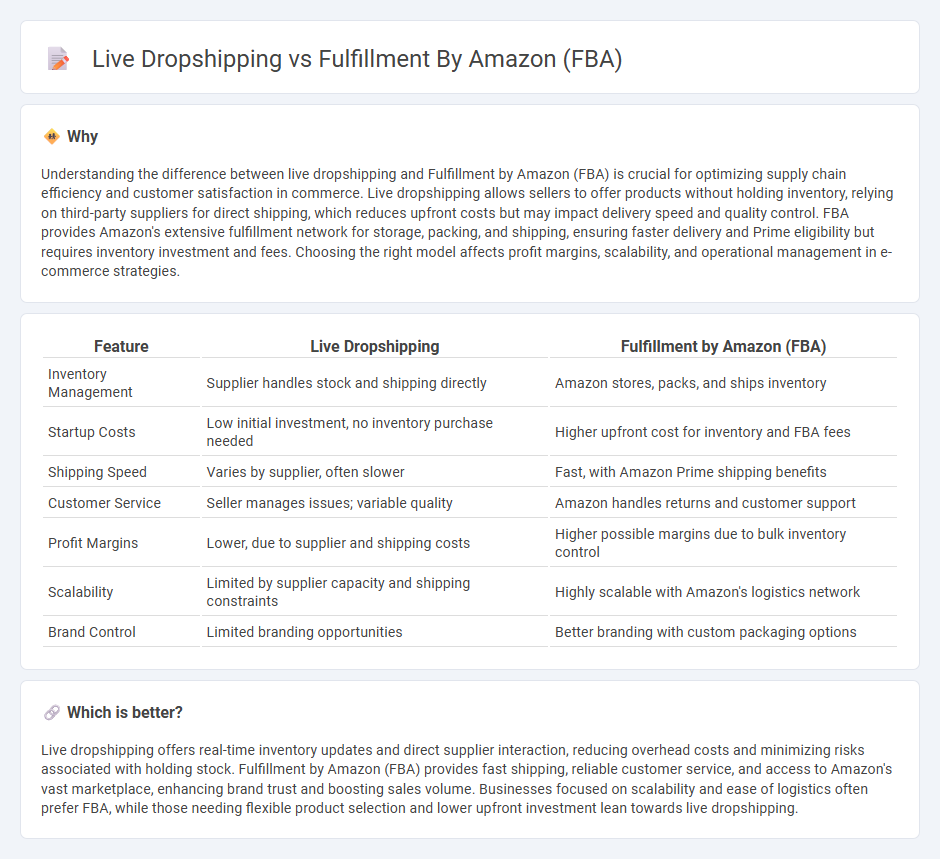
Live dropshipping offers entrepreneurs a low-overhead business model by directly shipping products from suppliers to customers without holding inventory, enabling rapid scalability and product testing. Fulfillment by Amazon (FBA) leverages Amazon's extensive logistics network, providing fast shipping, customer service, and Prime eligibility but requires upfront inventory investment and adherence to Amazon's policies. Discover the key differences and decide which e-commerce fulfillment strategy suits your business goals best.
Why it is important
Understanding the difference between live dropshipping and Fulfillment by Amazon (FBA) is crucial for optimizing supply chain efficiency and customer satisfaction in commerce. Live dropshipping allows sellers to offer products without holding inventory, relying on third-party suppliers for direct shipping, which reduces upfront costs but may impact delivery speed and quality control. FBA provides Amazon's extensive fulfillment network for storage, packing, and shipping, ensuring faster delivery and Prime eligibility but requires inventory investment and fees. Choosing the right model affects profit margins, scalability, and operational management in e-commerce strategies.
Comparison Table
| Feature | Live Dropshipping | Fulfillment by Amazon (FBA) |
|---|---|---|
| Inventory Management | Supplier handles stock and shipping directly | Amazon stores, packs, and ships inventory |
| Startup Costs | Low initial investment, no inventory purchase needed | Higher upfront cost for inventory and FBA fees |
| Shipping Speed | Varies by supplier, often slower | Fast, with Amazon Prime shipping benefits |
| Customer Service | Seller manages issues; variable quality | Amazon handles returns and customer support |
| Profit Margins | Lower, due to supplier and shipping costs | Higher possible margins due to bulk inventory control |
| Scalability | Limited by supplier capacity and shipping constraints | Highly scalable with Amazon's logistics network |
| Brand Control | Limited branding opportunities | Better branding with custom packaging options |
Which is better?
Live dropshipping offers real-time inventory updates and direct supplier interaction, reducing overhead costs and minimizing risks associated with holding stock. Fulfillment by Amazon (FBA) provides fast shipping, reliable customer service, and access to Amazon's vast marketplace, enhancing brand trust and boosting sales volume. Businesses focused on scalability and ease of logistics often prefer FBA, while those needing flexible product selection and lower upfront investment lean towards live dropshipping.
Connection
Live dropshipping and Fulfillment by Amazon (FBA) are connected through their shared focus on efficient order fulfillment and inventory management, allowing sellers to streamline sales without holding stock. Live dropshipping relies on real-time supplier updates to process orders, while FBA uses Amazon's extensive logistics network to store, pack, and ship products. Combining both methods enables e-commerce businesses to enhance customer experience by reducing delivery times and improving inventory accuracy.
Key Terms
Inventory Management
Fulfillment by Amazon (FBA) streamlines inventory management by storing products in Amazon's warehouses, enabling fast shipping and automated order processing, while live dropshipping requires real-time coordination with suppliers to fulfill orders without holding inventory. FBA benefits sellers by reducing logistics complexity and improving customer trust through Amazon's reliable delivery network, whereas live dropshipping demands precise supply chain communication to avoid stockouts and delays. Discover more about optimizing your e-commerce strategy with effective inventory management techniques.
Shipping Logistics
Fulfillment by Amazon (FBA) leverages Amazon's extensive warehouse network to ensure fast, reliable shipping with prime eligibility, while live dropshipping depends on third-party suppliers to handle order processing and shipping, often resulting in longer transit times and variable tracking reliability. FBA simplifies logistics by managing inventory storage, packaging, and shipping, reducing seller responsibilities and enhancing customer satisfaction through consistent delivery experiences. Explore effective shipping strategies and logistics optimization to decide the best fit for your e-commerce business model.
Order Processing
Fulfillment by Amazon (FBA) leverages Amazon's extensive logistics network to handle inventory storage, packing, and shipping, ensuring faster delivery and reliable order processing with real-time tracking updates. Live dropshipping involves sourcing products directly from suppliers who ship orders on demand, resulting in longer processing times and potential variability in shipping quality. Explore detailed comparisons to determine which order processing method aligns best with your e-commerce business model.
Source and External Links
Fulfillment by Amazon (FBA) - FBA is a program where Amazon handles storage, picking, packing, shipping, customer service, and returns for sellers, enabling fast Prime shipping and reducing fulfillment costs by up to 70% per unit compared to other carriers.
Amazon FBA for beginners - Sellers enroll products in FBA through Seller Central, then send inventory to Amazon's fulfillment centers, where Amazon fulfills orders including those from multiple sales channels or international customers.
What is Fulfillment By Amazon (FBA)? Definition & Cost - FBA allows sellers to outsource storage, shipping, returns, and customer service to Amazon, helping them focus on business growth while Amazon manages fulfillment logistics.
 dowidth.com
dowidth.com